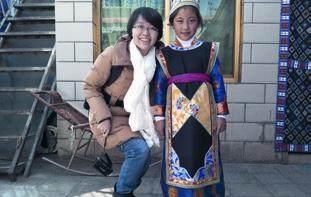Two Reporters,One Destination
This March 28 marked the 63rd anniversary of the emancipation of serfs in Tibet. Chen Zonglie, born in 1932, was a photojournalist who worked for Tibet Daily from 1956 to 1980, then Beijing Review from 1981 to 1996. He witnessed and recorded the changes in local people’s lives before and after the 1959 democratic reform in the region. Li Nan, born in 1982, is a reporter with Beijing Review. She visited Tibet Autonomous Region every year from 2017 to 2020.
The two Beijing Review journalists, with an age gap of half a century, both talked to people in the same place, namely Nyingchi, a city 391 km east of Lhasa. Both have set foot on all major parts of Tibet. In a reporting relay spanning more than 60 years, they have portrayed life in Tibet before and after the democratic reform, and in the new era. Excerpts of their accounts on their Tibetan adventures follow:
Chen Zonglie
I volunteered to work for the then newly founded Tibet Daily in July 1956. They were short of hands, especially photographers. I had taken photos for the Central Newsreel and Documentary Film Studio in Beijing before that.
There were three ways to reach Lhasa in the mid-1950s: on foot, on wheels or by air. I took the second approach—by truck, without seats. The road was either rough or muddy. When we came across sections where the layers of frozen earth were melting, it felt like we were driving on leavened dough. And we got stuck in the “dough”every now and then. Consequently, it took us 21 days to reach the regional capital from Xining in neighboring Qinghai Province, about 1,900 km northeast of Lhasa. I caught a bad cold on the way. It was really uncomfortable.
Tibet was ruled by feudal serfdom under a theocracy before 1959. It was peacefully liberated in 1951, but feudal serfdom was not abolished until eight years later. I visited some manor houses, and had a close look at the lives of the serfs.
In 1957, I visited the Golden Dragon Manor in Gyirong County, Xigaze. I was shocked by the living conditions of the serfs there. They were forced to work from dawn till midnight every day and lived and ate in the cowshed. What they had for supper was a bucket of tasteless soup with a few carrot slices floating on the surface and a bowl of tsampa made of pea flour, rather than highland barley flour. Tsampa made of pea flour is hard on human digestion, so peas were mostly used to feed livestock in Tibet. For the first time, I knew why the serfs were called “speaking livestock” by estate holders—that was exactly how they were treated.
The estate-holders could sentence a serf to death, even if they had done nothing wrong. I met a peasant named Tsering in Nyemo County in Lhasa. In Tibetan, the word tsering has an auspicious meaning of longevity. However, he almost died because of the name. One day, his drunken master burst into the place he lived in, smoking gun in hand. “Come over and raise your left arm, Tsering. Let’s use it as a target,” the master said.“Don’t be afraid. Your name is Tsering, which means longevity. If I can hit it, it means that you can survive and you are the true Tsering. If the bullet goes into another part of your body, you shouldn’t be named Tsering.” The poor peasant fell to the floor when the bullet entered his arm. He survived, but lost the arm.
“The evil master died in the armed rebellion in 1959. He sowed the wind and reaped the whirlwind,” Tsering told me. Then he showed me the dried dark arm that he had kept for years. “It’s part of my body, I don’t have the heart to desert it,” Tsering said.
Also, it was difficult for me to get local people to agree to be photographed back then. Many of them believed that the flash could steal the soul.
The turn came in March 1959. Some members of the Tibetan ruling class staged an all-out armed rebellion in Lhasa in an attempt to preserve serfdom forever. In response, the Central Government dissolved the government of Tibet and quelled the rebellion. At the same time, the democratic reform began. Land, houses and other means of production were distributed to peasants and serfs.
In a manor in Dagze County on August 25, 1959, I found former serfs, including Galsang, burning the documents of indenture that had bound them in servitude to their feudal landlords. I captured the moment with my camera.
I had more chances to visit remote areas in Tibet after the democratic reform, but transportation remained a major challenge. Sometimes, I got free rides on mail trucks. But most of the time, I rode either horses or bicycles to get around in the 1960s. It took me 17 days to travel from Lhasa to Nyingchi—two days by bike and another 15 days on horseback, along the Yarlung Zangbo River.
When I first met Nima Tashi, the giant scars on his face were striking. He was a hunter-turnedfarmer and was elected as the first mayor of Dongjug Township, Nyingchi. His wife, Galsang Yangjen, was born into a blacksmith’s family. The laws of old Tibet divided people into three classes and nine ranks, legalizing the unequal status of different groups. According to the old law, the couple were categorized as the lowest rank, with no access to political rights. Hunting was the only way for them to make ends meet. The scars were left on his face after a brown bear attack.
It was the democratic reform that empowered Nima Tashi with the equal right to stand for election. And, under the reforms, hunters were encouraged to take up farming in order to protect the region’s wild animals. Nima Tashi did just that, and I lodged with them every time I visited the township.
When I was in Nyingchi, I loved to venture outdoors with local friends in a nearby wild peach forest. In spring, the field and mountains were dotted with pink and white blossoms. In autumn, the trees were laden with ripe peaches. Besides making naturally dried peaches under the sunshine, the locals didn’t know how to process them. Some fruits rotted away. Little income was gained from the peaches.
I revisited Tibet in 1987 and 1990, as a reporter with Beijing Review. Some of my old friends had passed away. I met Galsang, one of the serfs who set fire to the documents of indenture in Dagze County in August 1959. She was living in a fivebedroom house. Her grandson was studying in Lhasa. Obviously, her life was much better than when we’d first met three decades earlier.
Li Nan
My first trip to Tibet came as a pleasant surprise. One of my colleagues was invited to cover the Tibetan New Year in 2017, but he wasn’t available that week. I filled the gap and hopped on a flight to the plateau two days later!
The first visit was filled with festivity and delicious food. I fell in love with the region and have visited it four times so far.
Of course, I always took the third approach: flying. It is a four-and-a-half-hour flight from Beijing to Lhasa. Except for the usual air turbulence near Lhasa, everything ran smoothly.
The travel time from Lhasa to Nyingchi is now much shorter than in the 1950s, but in 2017, the highway connecting the two cities was still under construction. Our van had to climb across the 5,013-meterhigh Mon La Pass and then circle back down. The journey took us almost six hours. Two years later, travel time was cut to four hours as the last section of the Lhasa-Nyingchi Highway was tunneled through. It’s the highest tunnel in the world. Now, with the opening of the Lhasa-Nyingchi Railway, the region’s first electrified railway, in June 2021, the journey takes only three and a half hours.
I have visited Nyingchi three times and made some friends there. He Xiaoxue is one of them. Both He and her husband are civil servants, respectively working in Nyingchi and Lhasa. The towering mountains standing between the two cities used to keep the couple apart.“We used to reunite once a month before the highway opened. Now, we can meet at least once a week,” she told me.
Also, I knew another Tsering in Tibet. Nima Tsering, 54, is a resident of Barka Village in Bomi County, Nyingchi. When he was young, every household in the village had a gun hanging on the wall.
Overhunting once reduced wild animal populations in the area, but the situation was reversed gradually after a national-level nature reserve was established in 1984. Hunting is prohibited and every one of the former hunters in Barka Village was hired by the local government to act as forest ranger, making an annual income of 13,000 yuan ($2,053).
Their conservation efforts paid off. Wild animals, such as bears and monkeys, have returned. With wild fauna and peach forests, Barka Village became a wellknown tourist destination. Since 2009, tourists have flocked to enjoy the pristine landscape and experience original Tibetan life in the village.
Villagers, including Nima Tsering, opened up guesthouses to accommodate tourists. In 2020, the average income of Barka villagers stood at 35,976 yuan ($5,673), 3,787 yuan ($597) more than the country’s per-capita disposable income for the same year.

The villagers call the income hike a gift from nature. “As long as the mountains remain green, the waters clear and the skies blue, we will be able to enjoy the gifts of the mountains and forests for a long time to come,” Nima Tsering said.
The Tibetan people’s attitude toward cameras has also changed, and cameras are no longer regarded as tools to steal souls. Some locals even live-stream every day to promote their guesthouses.
Phuntsok, a 74-year-old family inn owner in Tashi Gang Village of Lhulang Town, Nyingchi, is remarkably Web savvy. Phuntsok promotes his guesthouse on Weibo, the Chinese equivalent of Twitter, and WeChat, China’s most popular multipurpose social media platform; and through live-streaming.
Since 2016, free Wi-Fi has been available in rural Nyingchi with the help of the local government. A specialized online platform for promoting tourism was also established that same year and a free training course on how to use online marketing was offered to family hotel owners. This was grist to the mill for Phuntsok.
Today, Phuntsok’s guesthouse has become one of the most popular inns in Nyingchi. Celebrities and backpackers queue for a room in the lead-up to the peak season. In 2017, he received nearly 7,000 guests, raking in a yearly income of 350,000 yuan ($55,840).
The region’s abundant peaches are also being put to good use. Some villagers have built food-processing factories in the region to produce various specialties and sell those to incoming tourists.
“Ecological tourism now draws visitors to the region’s sleepy villages, bringing marked change to local views on green development,” Tanzin Samdrup, head of the Nyingchi Tourism Development Commission, told me.
Because of the pandemic, I haven’t visited Tibet for two years. My next plan? Fly to the plateau, take the Lhasa-Nyingchi Railway, stay at Nima Tsering’s guesthouse, chew on the dried peaches, and join Phuntsok’s live-stream! BR

